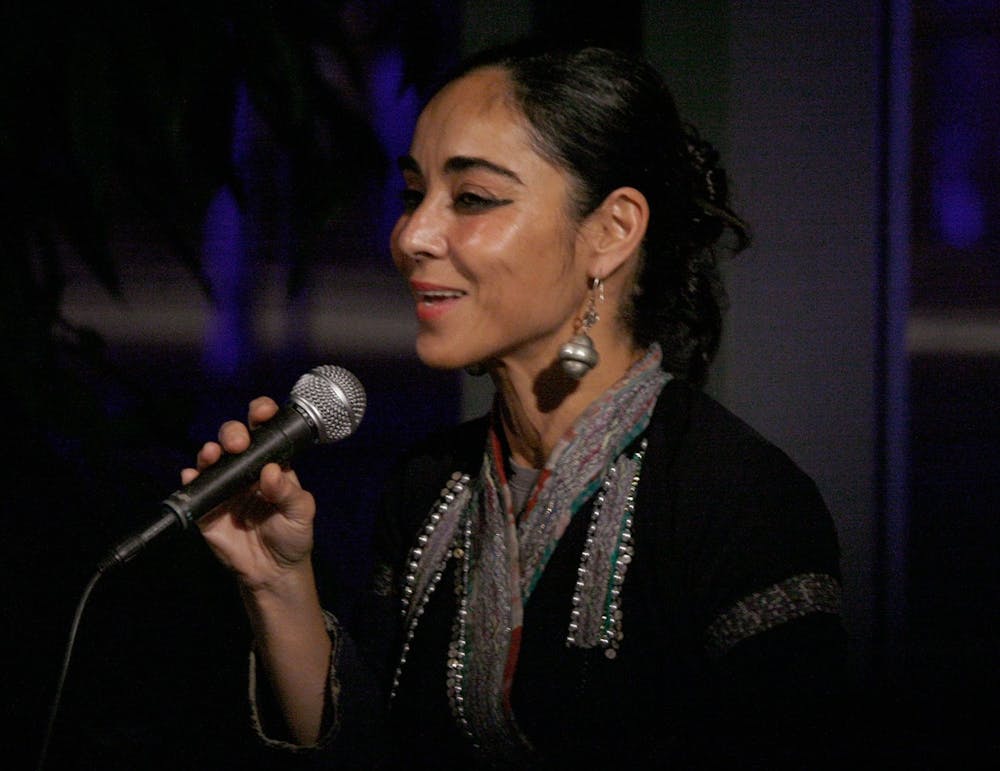I first became familiar with Shirin Neshat during my senior year of high school. Her piece “Rebellious Silence,” a black and white photograph of a woman’s face bisected by a gun barrel and written over with Farsi poetry from her “Women of Allah” series, was a standout work in the Global Contemporary section of the AP Art History exam’s 250 works.
The themes of this piece — the complex reality regarding the world’s perception of relationships between Islam and women, women and institutions of power, women and the west, Islam and the west, nature and civilization, violence and femininity and autonomy and social constraints — stood out as striking and direct. They also permeate Neshat’s entire career, from the early 1990s to the present, a collection of which is currently on display at The Broad museum in Los Angeles.
The Broad, a frequent destination for art enthusiasts and Instagram connoisseurs alike, boasts both an impressive permanent collection (with Kara Walker, Murakami and Basquiat to name a few), as well as a rotation of extensive and captivating artist showcases in the gallery spaces on the first floor. It is here that I reencountered Neshat.
Neshat’s exhibit, titled “I Will Greet the Sun Again,” explores the artist’s photography and surrealist films from over 25 years of extensive work. It begins where I, too, began my understanding of Neshat’s work with her “Women of Allah” photography cycle. Poetry written in Farsi by women on differing sides of the Iranian revolution, exploring topics like feminism or martyrdom, is embossed over black and white photos of women, sometimes accompanied by men, some with children, some alone and some reduced to just their hands or profile.
Often, the women address the camera directly, and many of the photos, especially those exploring martyrdom and sacrifice, are accompanied by a gun that at once overwhelms the image and translates as almost unrecognizable to the viewer. These photographs and the accompanying surrealist videos that explore relations between men and women, as well as between the city and nature in a clearly Islamic society, set the foundation for the rest of Neshat’s work.
It also provides context, as for much of the rest of her artistic career Neshat has lived in exile in the United States due to increasingly hostile circumstances in her homeland and the Islamic Republic’s denouncement of her work.
In fact, the end of the “Women of Allah” series — a group of photographs depicting women posed within a staged garden — were taken on one of her last trips to Iran, during which she was detained by airport security.
Neshat’s work continues to explore recurrent themes from her early work, while also taking on considerations about exile and political engagement. Her next series of photographs, “Soliloquy,” which were the only color photographs on display, explores the psychology of architecture and ritual from East to West, often with Neshat as the subject.
The work was accompanied by two films: one depicting sanctuary and invasion in a walled garden in Mexico; one exploring burial practices and gender roles in the desert. Neshat then turned her attention to portraiture, photographing first activists with Persian story elements drawn on them, then Egyptians who had lost their homes and loved ones during the Arab Spring. In this series, “Our House is On Fire,” Neshat again inscribes miniscule Farsi text across the faces of the subjects.
The rest of the exhibit includes photographs that focus on the people of Azerbaijan and the American West displayed in salon style, and four movies that depart from her previous work, which focused primarily on group movement. One stars Natalie Portman chasing a figure along a beach and through an old mansion, another is a surreal encounter with a mother and shame, while two more document a dream collector in the American Southwest.
While the last movie could not exist in a more different world than the first photographs, the museum tangibly threads Neshat’s growth as an artist throughout the exhibit, making it coherent and digestible.
However, while breadth and evolution of the work is impressive it is, at times, exhausting. The monochrome palette assists the eye in moving through the extensive exhibit, but my one critique would be that often the faces and individual pieces blur together because of the sheer scope of work one is trying to assess.
I would suggest a tip for tackling Neshat’s handiwork — clear your head, give yourself an entire day and let the pieces breathe. An artist that continues to address themes related to Islam that are often too uncomfortable to confront in a graceful and nuanced manner, especially in a post 9/11 world, deserves that much.





